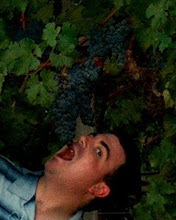Then there was Onion soup and triple cream brie grilled cheese sandwiches. The soup was made with Chardonnay and the creaminess in the brie paired perfectly with the Chard. I was stuffed.
 Steak salad with tons of goodies - greens, kalamata olives, cherry and green tomatoes, more goat cheese, and two types of bread with butter, of course. It was quite possibly one of the best salads I've ever had.
Steak salad with tons of goodies - greens, kalamata olives, cherry and green tomatoes, more goat cheese, and two types of bread with butter, of course. It was quite possibly one of the best salads I've ever had.
A 2002 Contra Costa V. Sattui in the middle flanked by two 2006 Zins from Monte Rosso Vineyard in Sonoma Valley. One from Stryker Sonoma and one from Amapola Creek.
Most people don't know that there are some awesome Zinfandel vineyards in Contra Costa County. It's darn near perfect growing conditions out there. This V. Sattui did not disappoint. It actually took a while to open up, but when it did it was surprisingly still fruit forward with a nice round and full mouthfeel.
Monte Rosso Vineyard has been around since the late 1800's and has some of the oldest Zinfandel vines in Sonoma Valley - if not the oldest. The Monte Rosso Zins were like night and day from each other. The Stryker was all raspberries and alcohol (though not in a bad way) and the Amapola was perfectly balanced with dark fruits, white and black pepper and a very long finish.
I think one of the biggest differences was the Amapola grapes came from vines planted in 1885 and the Stryker didn't. Thought I don't know the exact age of the Stryker grapes.
Our host surprised us with a chocolate almond flourless cake with whipped cream for dessert, and it was fabulous. Good thing I brought along with me an Arrowood 1993 Late Harvest Riesling. The wine looked like light roast coffee in the glass (as Rieslings age the color of the wines turns darker). The aromas were toffee, caramel and petrol (diesel), common of aged Rieslings. In the mouth the wine was sweet right away, but then that soon faded to flavors of espresso and mocha. This particular Riesling had 28% residual sugar at bottling - a very high sugar content. Most of us agreed (and I thought so) that this was the best wine of the night. It was outstanding.
The highlight of the evening was being able to spend time with some great friends. And as you know, I feel like the wine brought us closer together. So grab some different wines, invite from friends over (ask them to bring wine too) and have a get together. Try a sampling of foods with out of the ordinary wines and see what happens. I'll bet you have a great night.
Cheers!


 For starters, we opened the Tandem
For starters, we opened the Tandem 





 Cheers!
Cheers!
